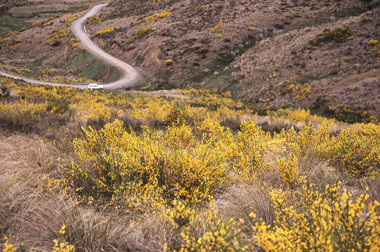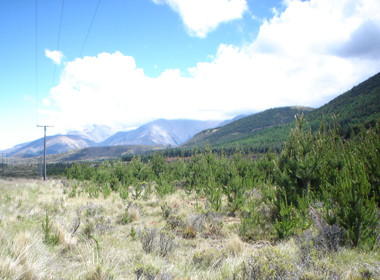 Cytisus scoparius (broom) at Jack’s Pass. Photographer: Peter Williams.Novel ecosystems (also termed ‘emerging’ or ‘synthetic’ ecosystems) include conditions and combinations of organisms never before in existence. These ecosystems can arise through environmental change, species invasion or both. Novel ecosystems result from human activity, but do not depend on continued human intervention for their maintenance. For example, novel ecosystems can develop on lands that were intensively farmed and then abandoned. These are particularly evident in regions where indigenous species are poorly adapted to overcome the legacies of intensive agriculture and exotic species invade in their place.
Cytisus scoparius (broom) at Jack’s Pass. Photographer: Peter Williams.Novel ecosystems (also termed ‘emerging’ or ‘synthetic’ ecosystems) include conditions and combinations of organisms never before in existence. These ecosystems can arise through environmental change, species invasion or both. Novel ecosystems result from human activity, but do not depend on continued human intervention for their maintenance. For example, novel ecosystems can develop on lands that were intensively farmed and then abandoned. These are particularly evident in regions where indigenous species are poorly adapted to overcome the legacies of intensive agriculture and exotic species invade in their place.
New Zealand is home to an increasing number of exotic plant species. The ubiquity of these species coupled with the history of human activity since the arrival of the first Maori settlers ~800 years ago, means that there have been opportunities for novel ecosystems to develop.Some current examples of novel ecosystems are:
- Tussock grassland below the treeline in the eastern South Island. This novel ecosystem occurs in areas where human-induced fires have eliminated the seed sources, soil biota and seed dispersers of the former (fire-sensitive) beech forest. More recently, grazing by sheep has driven further changes in the species composition of these grasslands. Removal of grazing sheep is likely to result in further invasion by exotic plants.
- Pine dominated ecosystems that develop where seedlings have spread from plantations or soil conservation plantings. For example, Pinus nigrareadily invades grazed montane grasslands in the eastern South Island. Pine forest is maintained by recruitment events that are triggered by fire or large-scale wind throw. Generally, Pinus species are likely to proliferate with the reduction in grazing pressure associated with land abandonment.
- Novel ecosystems comprised of gorse and indigenous species. These arise on abandoned farmland where indigenous propagules are available, disturbance is minimal and environmental conditions favour plant growth. In this situation, gorse probably facilitates the return of indigenous species but there is increasing evidence that the successional trajectory through gorse is different to that through the indigenous kanuka. Alternatively, mono-specific stands of gorse can develop on abandoned farmland with a long history of grazing and fire, if this is coupled with stressful environmental conditions and a lack of indigenous propagules.
 Pinus contorta invading grassland at Craigieburn. Photographer: Peter Williams.How should novel ecosystems be managed? In some instances, the novel ecosystem might function much like the historic ecosystem that they have replaced. Therefore, it could be argued that these ecosystems are acceptable analogues and intervention to restore historic species compositions is not required. We might instead focus on the restoration of novel ecosystems whose function has been altered or ecosystem services have been lost. On the other hand, restoration goals are often directed towards the place-based conservation of particular species or ecosystems. In this decision framework, novel ecosystems are not acceptable analogues for historical ecosystems and intervention is necessary. Both views are valid depending on how we value nature. The increasing prevalence of novel ecosystems is forcing us to re-think both the options for their management and the broader goals of ecosystem restoration and conservation.
Pinus contorta invading grassland at Craigieburn. Photographer: Peter Williams.How should novel ecosystems be managed? In some instances, the novel ecosystem might function much like the historic ecosystem that they have replaced. Therefore, it could be argued that these ecosystems are acceptable analogues and intervention to restore historic species compositions is not required. We might instead focus on the restoration of novel ecosystems whose function has been altered or ecosystem services have been lost. On the other hand, restoration goals are often directed towards the place-based conservation of particular species or ecosystems. In this decision framework, novel ecosystems are not acceptable analogues for historical ecosystems and intervention is necessary. Both views are valid depending on how we value nature. The increasing prevalence of novel ecosystems is forcing us to re-think both the options for their management and the broader goals of ecosystem restoration and conservation.
For more information see*:
- Hobbs, RJ, Higgs, E, Harris JA 2009: Novel ecosystems: implications for conservation and restoration. Trends in Ecology and Evolution 24: 599-605.
- Standish, RJ, Sparrow, AD, Williams, PA, Hobbs, RJ 2008: A state-and-transition model for the recovery of abandoned farmland in New Zealand. In: New models for ecosystem dynamics and restoration, RJ Hobbs and KN Suding (eds), pp. 189-205. Island Press, Washington.
* The Network is not responsible for the content of external internet sites
